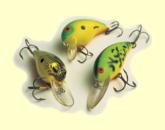Wide wobblers
These baits wobble, but they don’t let you down
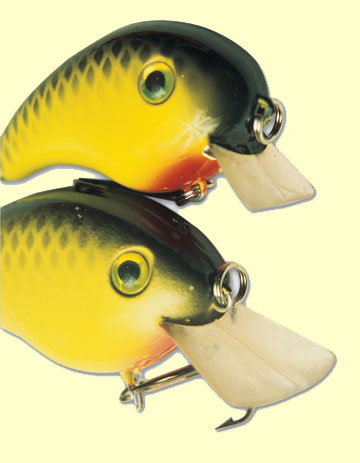
When most anglers contemplate which crankbait to tie on, diving depth is their first priority. Of the many important secondary factors, such as size and color, a crankbait’s action often fails to get the concern it deserves.
Arkansas’ George Cochran and New Hampshire’s Rick Lillegard cast crankbaits that swim with everything from quick shimmies to lazy wobbles. These Wal-Mart FLW Tour pros hold strong opinions about when different crankbait actions excel, and they believe every serious bass angler should carry an assortment of wide wobblers.
“My favorite crankbaits for fishing shallow water from spring through fall have wide wobbles and square lips that help them bump through cover without snagging,” Cochran said.
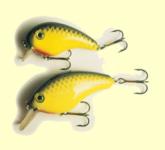 Snag resistance is crucial, because Cochran continually bustles these crankbaits over logs, stumps, grass, riprap and other shallow cover. He fares well with 3/8-ounce baits that run 2 to 4 feet in stained to muddy water. Smaller 1/4-ounce baits that run 2 to 5 feet come through for him in stained to lightly stained water. He usually fishes the larger crankbaits on 15-pound P-Line and the smaller baits on 10- to 12-pound line.
Snag resistance is crucial, because Cochran continually bustles these crankbaits over logs, stumps, grass, riprap and other shallow cover. He fares well with 3/8-ounce baits that run 2 to 4 feet in stained to muddy water. Smaller 1/4-ounce baits that run 2 to 5 feet come through for him in stained to lightly stained water. He usually fishes the larger crankbaits on 15-pound P-Line and the smaller baits on 10- to 12-pound line.
“Lighter line gives the little baits better action and lets them run deeper,” Cochran said. “If I’m fishing extremely thin water, I switch to 20-pound-test with both crankbaits. A heavy line makes them run shallower and bounce off cover better.”
In muddy water and under windy, overcast conditions, Cochran maintains a medium-speed retrieve. In lightly stained water that has better visibility, he uses a faster retrieve. Whatever the retrieve speed, he hesitates for a moment after the crankbait ricochets off an object.
“In the summertime, I’ve had some awesome days grinding these crankbaits over cover as fast as I can,” Cochran said. “When bass won’t look at a slow crankbait retrieve, they’ll strike reflexively when you burn the bait past them.”
A Daiwa 6-1 gear ratio bait-casting reel and a medium-action Daiwa fiberglass cranking rod get the call when Cochran puts wide wobblers to work. He favors a 7-foot rod because it casts far with little effort. A typical cast for him is 30 yards.
“I like to stay well back from cover, especially in shallow water,” Cochran said. “When you get too close to bass, the trolling motor spooks them. Most people don’t realize that.”
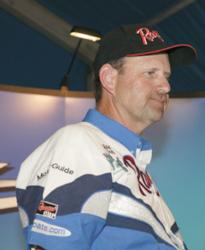 A 6- or 6 1/2-foot rod gets the call when accurate, close-quarter casts to dense cover are the order of the day. That was exactly the situation when Cochran fished an FLW Tour event on the Red River. He found bass holding tight to brush, flooded bushes and logs scattered about on shallow flats. As he wove his boat through the maze, he made 20- to 30-foot casts. Longer casts would have allowed bass to snag the line on the heavy cover before they could be landed.
A 6- or 6 1/2-foot rod gets the call when accurate, close-quarter casts to dense cover are the order of the day. That was exactly the situation when Cochran fished an FLW Tour event on the Red River. He found bass holding tight to brush, flooded bushes and logs scattered about on shallow flats. As he wove his boat through the maze, he made 20- to 30-foot casts. Longer casts would have allowed bass to snag the line on the heavy cover before they could be landed.
Cochran’s most productive presentation on the Red River was to retrieve a shallow-running 3/8-ounce crankbait parallel to logs and to bump the wood with the bait as much as possible. He also duped many bass by casting beyond flooded bushes and guiding the crankbait with his rod so it tapped the base of the cover. A medium-speed retrieve netted Cochran enough bass for a top-10 finish.
Lillegard rarely cranks wide-wobbling crankbaits at a fast clip. He believes slow-to-medium retrieves allow the mesmerizing side-to-side action to work its magic in the strike zone just that much longer.
“Crank too fast, and you pull wide-wobbling crankbaits out of the action they were designed for,” Lillegard said. “That’s the beauty of these lures. I think bass see them as a crayfish digging bottom.”
Lillegard opts for a 5-1 gear ratio Quantum Energy PT bait-casting reel to avoid overworking wide wobblers. He spools the reel with green Silver Thread 12- or 14-pound line and matches it with a 6-foot medium-action Quantum bait-casting rod.
Cordell’s 1/4-ounce Baby Wiggle “O” and 3/8-ounce Wiggle “O” tempt bass when Lillegard wants to show the fish a wide-wobbling crankbait. The Baby Wiggle “O” runs to 6 feet deep; the Wiggle “O” digs 8 to 12 feet deep. Lillegard bounces both baits over boulders and riprap and scores well with largemouth and smallmouth bass.
“These baits are designed to be erratic,” Lillegard said. “Every once in a while they break out of their rhythms and skip a beat. It’s the kind of change-up that gets spontaneous strikes from bass.”
When largemouths hold in grass that grows to within a foot of the surface, Lillegard makes hay with a 3-inch Big “O.” He holds his rod high and cranks slowly to make the fat, wide-wobbling bait boil across the surface. In Northeastern waters near his home, coontail and milfoil predominate. Most bass charge up from holes within the grass created by large boulders or clean, sandy patches of bottom.
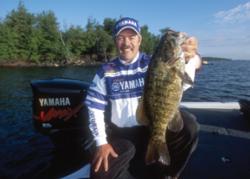 A wobbling-wake presentation also comes through for Lillegard in other parts of the country. While fishing an FLW Tour event on Sam Rayburn a few years ago, he ran a Big “O” over grass growing on secondary points in major creeks. The prespawn fish were staging on the very tops of the points, and Lillegard picked off enough of them to finish in 20th place. His heaviest bag weighed more than 17 pounds.
A wobbling-wake presentation also comes through for Lillegard in other parts of the country. While fishing an FLW Tour event on Sam Rayburn a few years ago, he ran a Big “O” over grass growing on secondary points in major creeks. The prespawn fish were staging on the very tops of the points, and Lillegard picked off enough of them to finish in 20th place. His heaviest bag weighed more than 17 pounds.
When bass want a faster-wake bait, Lillegard gets their goat with a 2-inch Bomber Shallow “A.” Since the Shallow “A” is made to run less than 1 foot deep at any speed, it can rake the surface at an upbeat pace.
When he fishes laydowns and other wood cover, Lillegard prefers Bomber’s 6A and 7A crankbaits. He claims these wide wobblers are two of the best crankbaits ever made and that they bounce nicely off tree limbs.
“The 6A and 7A are wonderful for making multiple casts into a tree,” Lillegard said. “Try to get as many different types of deflections as you can. Keep working on the cover, and you can make a bass strike.”
Tight vs. wide wobble
“In cold water, bass respond better to a tight-wobbling crankbait,” said FLW Tour pro George Cochran. “All fish are conserving energy then, and they use the least amount of energy they can get by with. Baitfish move in short bursts.
“When the water heats up in the summertime, fish get sluggish and swim with a lazy wobble. Bass think a wide-wobbling crankbait is a big shad or a big bream. A wide wobble looks natural to them at that time.”
“The predominant forage in the Northeast is yellow perch,” said Wal-Mart FLW Tour pro Rick Lillegard. “That’s why I use patterns that have a lot of yellow, orange and chartreuse. I especially like crankbaits that have orange bellies. In murky water, I throw a lot of firetiger and brown crawdad patterns.”
Anytime Wal-Mart FLW Tour pro George Cochran fishes murky water, he depends on a chartreuse crankbait with a black back. When bass spawn in the spring, he scores big with a crawfish pattern that has a reddish hue. In the fall, he switches to white and natural shad colors.
